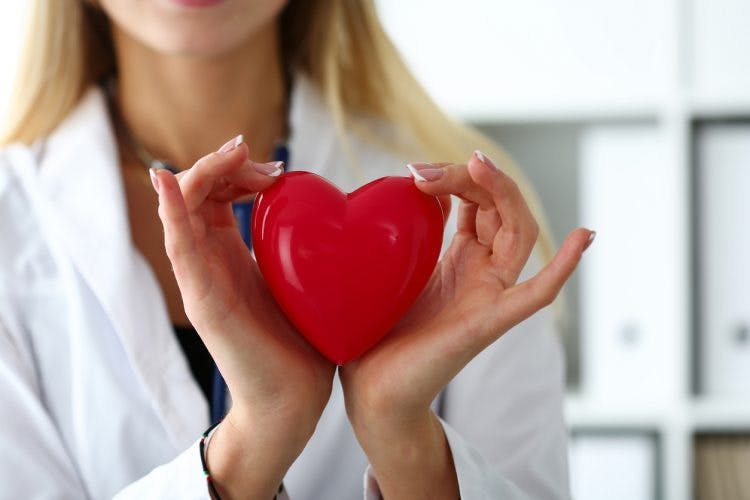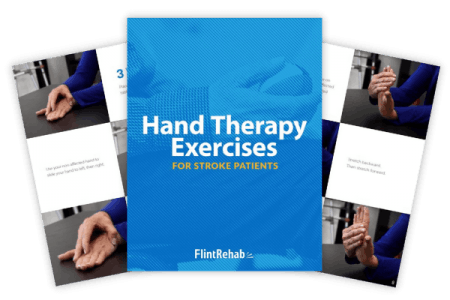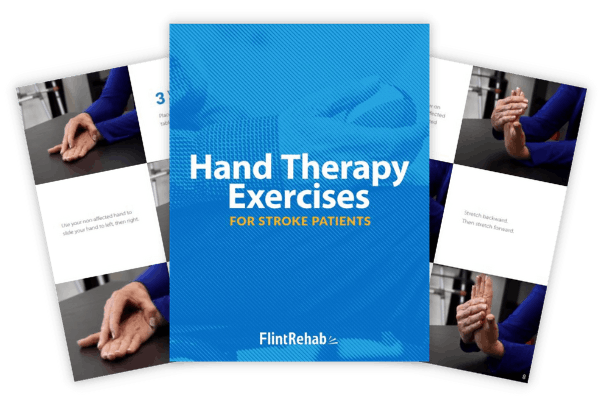No products in the cart.
No products in the cart.
No products in the cart.
No products in the cart.
Home » Neurological Recovery Blog » Stroke » Maximizing Hand Recovery After Stroke: How to Improve Hand and Finger Mobility
Last updated on December 12, 2022

Hand recovery after stroke can be a slow process, affecting many daily activities. However, we now know that recovery of hand function can continue to occur months, and even years, following stroke.
The chances of hand recovery increase with consistent practice and repetition of rehabilitation exercises. In this article we will discuss techniques to maximize recovery after stroke and promote return of hand function.
Hand function is often one of the slowest to return after stroke. Since the hands and feet are distal to (far away from) the midline of your body, this means they are also located farthest from the brain and spinal cord. This increases the distance nerve signals must travel to communicate. Following a stroke, this communication is often delayed or inhibited, resulting in decreased hand function.
Additionally, the muscles of the hand are small and tend to fatigue quickly. Inhibited muscle activation and decreased use of the hand after stroke can cause muscles to atrophy, or become smaller and weaker. This contributes to diminished hand function and extreme difficulty with fine motor movements.
As many as 80% of stroke survivors experience arm and hand impairment, which can dramatically affect performance of daily activities such as dressing, bathing, and cooking. Although hand recovery after stroke can be slow and, at times, frustrating, there is always hope for regaining function through consistent rehabilitation. To help maximize progress and functional performance, here are some fundamental treatment aspects for hand recovery:
Rehabilitation exercise is perhaps the most crucial aspect of fine motor recovery after stroke. Practicing intentional movements of the hand is vital to help regain lost function and it is important to begin exercising as soon as possible.
Focus on practicing hand therapy exercises to improve your fine motor skills and coordination. Ideally, you can practice the exercises and skills your occupational or physical therapist suggests, or you can use our hand exercises for stroke patients.
While traditional exercise focuses on strengthening muscle groups, the main goal of hand rehab exercise after stroke is connecting the brain to the body through intentional movement. This helps promote motor relearning and improvement in performance of daily tasks.
Want 25 pages of hand therapy exercises in PDF form? Click here to download our free Hand Therapy Exercise ebook now (link opens a pop up for uninterrupted reading)
Following a neurological injury such as stroke, your brain relearns skills through neuroplasticity. Neuroplasticity refers to your brain’s ability to rewire neural pathways and connections, allowing other parts of the brain to adapt and compensate for lost function. This process is activated through rehab exercise and, more specifically, high repetition of those exercises.
Practicing high repetition of a specific skill or task maximizes motor relearning and neuroplasticity. The more you practice rehab exercise, the more your brain rewires itself, and the more movement you recover. This means that if you want to regain use of your hand after stroke, you need to use your hand often. This will stimulate your brain and encourage it to improve control of your hand function.
In addition to high repetition, another vital aspect of hand recovery after stroke is consistency. The only way to enhance recovery and notice steady improvement in hand function is through frequent, consistent practice. Repetitive practice will be the most effective when it is performed on a daily basis. This consistent stimulation helps your brain create and retain the new neural pathways that you’re building through exercise.
Talk with your rehab team about a rehabilitation exercise program that will help you achieve your hand recovery goals after stroke. It is important to find exercises you can be consistent with to maximize your functional outcomes. It is also important to find a hand therapy program that you enjoy, as this will help you be more consistent.
Additionally, it can be beneficial to create a consistent schedule or routine to make your exercise program a daily habit. Prioritizing your rehab exercises allows you to improve your chances of recovery and take charge of your healing.
Rehabilitation exercise, high repetition, and consistency are three fundamental components of effective hand recovery after stroke. These fundamentals are vital for promoting neuroplasticity and regaining hand function. Now that we have discussed the basic components of hand recovery, we will review additional treatment methods that can improve functional outcomes after stroke.
It is important to find hand exercises you enjoy and can be consistent with in order to enhance your recovery after stroke. At times, rehabilitation exercise can feel tedious, or you may become frustrated if you experience occasional plateaus in your progress. To help achieve the high repetition necessary for hand recovery after stroke, you can try fun, high-tech devices like Flint Rehab’s MusicGlove.
MusicGlove is clinically proven to improve hand function within 2 weeks as it makes exercise more engaging and can motivate you to accomplish hundreds of repetitions per exercise session. Additionally, your therapy team may be able to help you identify exercises that coincide with your hobbies or other activities you enjoy to help you maintain consistency and stay motivated.
Mirror therapy is another technique that can be used to maximize hand recovery after stroke, especially for individuals who have minimal hand function. This is a standard hand recovery method for individuals with severe hand paralysis and is also highly effective for reducing clenched hands after stroke.
Mirror therapy involves placing a tabletop mirror over your affected hand so that it reflects your unaffected hand. Rehabilitation exercises are then performed with your unaffected hand as you watch the reflection in the mirror, “tricking” your brain into thinking you’re moving your affected hand.
This technique can spark neuroplasticity and help you create new neural pathways, allowing you to regain movement or fine motor skills in your affected hand. As with other techniques, repetition and consistency are necessary for mirror therapy to be an effective treatment.
Electrical stimulation involves using electrical currents via electrodes placed on the skin to provide stimulation to your nerves and muscles. This therapy technique amplifies the stimulation your brain receives and can help enhance neuroplasticity, improving rewiring of new motor pathways.
Electrical stimulation is a commonly used method to help patients recover from paralysis after stroke and can be applied to the hands, wrists, and arms to promote muscle activation and stimulation. There is widespread evidence to support the use of electrical stimulation for hand recovery after stroke. Talk with your doctor or therapist before beginning this treatment to determine if electrical stimulation is appropriate for you.
It is important to note that electrical stimulation is most effective when paired with rehab exercise. Sometimes referred to as functional electrical stimulation or FES, this specific type of electrical stimulation is applied to your muscles to increase contraction while you perform a series of exercises or tasks. This maximizes muscle activation and enhances neuroplasticity, promoting recovery of fine motor skills and lost function.
Mental practice is the art of visualizing yourself performing a specific movement or task. This treatment method can be used to help improve motor function and is especially helpful for stroke survivors who have limited hand function. This technique can be performed before and after your regular rehab exercises to enhance recovery.
Even if you have minimal or no hand function after stroke, mental practice can help your brain “rehearse” and rewire the connections needed to perform a specific movement. In this way, mental practice can engage neuroplasticity in the same way as physical practice. This technique has been clinically proven to boost results and is even used by professional athletes to visualize skills and successful outcomes before competition.
A large percentage of stroke survivors experience hand involvement, which can affect many daily tasks and activities. Although hand recovery after stroke may be slow or frustrating, there is hope for recovery with a comprehensive rehabilitation program that focuses on neuroplasticity.
Neuroplasticity is optimized when recovery includes three fundamental components: rehabilitation exercise, high repetition, and consistency. Additionally, supplementary treatment methods such as electrical stimulation, mirror therapy, mental imagery, and MusicGlove can improve the likelihood of hand recovery after stroke. We hope this article helped review methods for hand recovery that you can use during your own rehab journey.

Do you have this 25 page PDF of beautifully illustrated hand therapy exercises? You don’t want to miss this!
The best way to improve hand mobility after a stroke is to practice hand therapy exercises. Sign up below to get your copy of this free ebook.
You’ll also receive our weekly Monday newsletter that contains 5 articles on stroke recovery, and you can unsubscribe at any time.


Do you have this 25-page PDF of hand exercises?
Get a free copy of our ebook Hand Therapy Exercises for Stroke Patients. Click here to get instant access.
If you want to motivate yourself to accomplish the high repetition of hand exercises necessary for recovery, then you need to meet the MusicGlove.
Created by Flint Rehab (who also created the blog you’re currently reading), this hand therapy tool is clinically proven to improve hand function within two weeks of use when used for at least 25 minutes a day.
See how other survivors have improved hand function with it:
“My wife suffered a stroke that resulted in her being paralyzed on her left side. She did not have the use of her left hand, even after going through physical therapy in the hospital.
I had ordered the MusicGlove, along with the FitMi system and had them ready for her when she arrived home from the hospital. She was unable to open, or separate, the fingers on her left hand, and seriously I had my doubts that the MusicGlove would work for her.
She has been home from the hospital a little over a month and thanks to this fabulous system, she is now able to not only spread her fingers out, but is able to use them at about 50% capacity.
We are thoroughly convinced that without the MusicGlove system her hand would be totally useless. We are looking forward to continued gains in the use of her hand and fingers. Thank you Flint Rehab for coming to our rescue.” –Mike S.
“We purchased the MusicGlove + FitMi pack for my mom after she suffered bilateral strokes. It’s so fun watching her play and it’s incredible how much her dexterity, range of motion, and strength has increased, even after only a few minutes a day. The Music Glove is a great way to improve while having fun doing it. I’m so thankful we found this product!” -Brenna
“We bought the MusicGlove for my brother, Kevin, after he had a stroke 5 years ago. This device has been so very helpful in his recovery! He has regained movement in his fingers which is just short of a miracle! It is such good therapy for him both physically and mentally!
Not only do we feel the physical movement helps but it’s a bit of music therapy also! He enjoys the variety of songs to choose from along with different levels of difficulty. It’s been worth every penny and then some! His physical therapist says it’s priceless!!” –Lori
Not only is MusicGlove beloved and approved by survivors, but it’s also used in the top rehab clinics in the world, including the Shirley Ryan Ability Lab, the #1 ranked hospital in America.
When you choose to use MusicGlove, you’re in good company. To learn more about the hand therapy device from Flint Rehab, click the button below:
Grab a free rehab exercise ebook!
Sign up to receive a free PDF ebook with recovery exercises for stroke, traumatic brain injury, or spinal cord injury below: